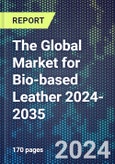The Global Market for Bio-based Leather 2024-203 analyzes plant-based, mycelium, microbial, lab grown and protein leathers. It evaluates market size, demand by end use (footwear, fashion, automotive, furniture), competitive landscape, commercialization challenges, investment trends and growth projections across regions.
The report includes profiles of 60 companies leading the development of innovative biomaterials and biofabrication methods for leather production are included along with analysis of their partnerships, IP and M&A activity. In-depth segmentation is provided spanning raw material inputs, manufacturing processes, products, applications, and geography.
Historic and 11-year forecasted market data is quantified globally and for North America, Europe, Asia Pacific, Latin America, and MEA.
Impact of sustainability regulations and evolving consumer preferences on bio-based leather adoption is assessed. Benchmarks are established comparing the properties, feel, strength, breathability and aesthetics of new sustainable leathers versus animal/synthetic alternatives in the context of identified use cases.
Report contents include:
- Overview and properties of different sustainable leather types – plant-based, mycelium, microbial, lab grown
- Production processes for bio-based leathers and commercial activity
- Benchmarking strengths and weaknesses of new sustainable leathers
- Company profiles for 60 players on partnerships, funding, IP landscape. Companies profiled include Arda Biomaterials, Evolved by Nature, Gozen, Modern Meadow, MycoWorks, NFW, Polybion, and UNCAGED Innovations.
- Commercialization analysis - recent investments, SWOT assessment by market
- Markets and applications in footwear, fashion, automotive, furniture, consumer goods
- 11 year historic and forecast demand globally, by region, by end use segment
- Market drivers and trends evolving from sustainability regulations and preferences
- Challenges around industry adoption, manufacturing, achieving desired feel/aesthetics
- Tech advancements and innovations in bio-inspired design, novel biomaterials
- Funding levels analysis - total amounts, breakdowns by company from 2018-2023
- Announcements of latest industry partnerships, product launches, expansion plans
Table of Contents
1 RESEARCH METHODOLOGY
Companies Mentioned (Partial List)
A selection of companies mentioned in this report includes, but is not limited to:
- Arda Biomaterials
- Evolved by Nature
- GANNI
- Gozen
- Modern Meadow
- Modern Synthesis
- MycoWorks
- Nike
- NFW
- North Face
- Pangaia Lab
- Polybion
- UNCAGED Innovations
- Vegea
Methodology

LOADING...








